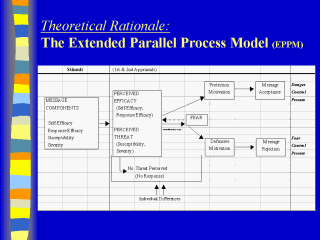| front |1 |2 |3 |4 |5 |6 |7 |8 |9 |10 |11 |12 |13 |14 |15 |16 |17 |18 |19 |20 |21 |review |
 |
1. Threat motivates action, efficacy determines nature of
the action. 2. When threat is low, there is NO response to the message (itís not even processed, efficacy is not considered. 3. When threat is high, and efficacy is HIGH, then people CONTROL THE DANGER and protect themselves. 4. When threat is high, and efficacy is LOW, then people CONTROL THEIR FEAR and ignore the message. 5. Critical to measure both INTENDED and UNINTENDED campaign outcomes, to see if thereís NO response to your campaign versus a fear control response (can both look like NO response). |